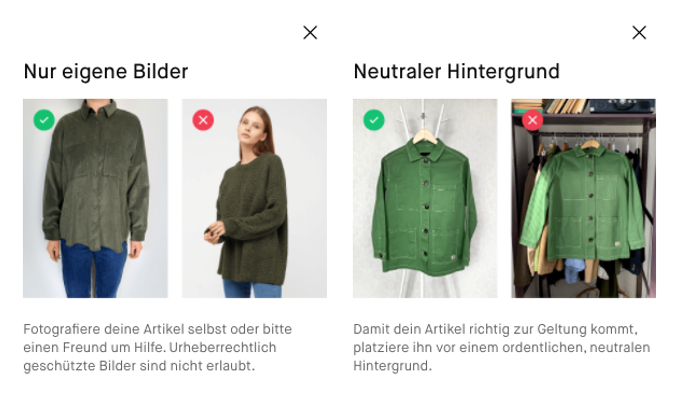 Source: iStock.com/monstArrr_
Source: iStock.com/monstArrr_
The top tips and trends for selling clothes by app and smartphone
2. March 2021 Published by Raphael DoerrGermans like mobile shopping – and the smartphone is growing in importance as a shopping portal among just about all age groups. The items most frequently purchased are clothing and shoes (63 percent), according to a study. But what about selling clothes, books or CDs by smartphone? Our blog post looks at the subject of selling things by app and smartphone. What are the preferred apps for that, where can you really get cash for cast-offs, and why are good photos important to sell stuff? To make sure we don’t go off topic, we’ll confine ourselves to clothes.
The obligatory spring clean is on the agenda and that also means tidying up and clearing out your wardrobe – and wondering how you could have amassed so much over the years. One tip here is to narrow down what you want to sell in advance, for example, by dividing the clothes into “brand-name/designer items,” “vintage,” “no-name products,” “funny/exotic” and “out.”
Brand-name products are always snapped up, although upmarket designer and fashion items shouldn’t be more than five years old, as some premium second-hand platforms won’t buy them otherwise. If the “rags” are older, but still in good condition, then you should collect and categorize them under “vintage,” since there’s also a large buyer community for them. “No name” and “funny” are typically stuff for the flea market; you can’t go wrong here and you’re happy if the T-shirts, capes and shoes sell over the virtual shop counter for a few euros extra. “Out” is out and if you don’t want to take them to the clothing drop box, you can try your luck using one of the flea market apps. And you should decide beforehand what price you want for them. Whether you want to auction them off, define a fixed price or accept the price bid on the well-known platforms: Here, too, you should always do a bit of research and check out comparable products – but don’t get mad if a similar jacket or pair of trousers has already been posted online at a cheaper price.
A big trend: second hand and recommerce
There are two particularly influential trends when it comes to selling clothes. First, large fashion chains are increasingly getting in on the act; second, recommerce is one of the top issues for many consumers who want to do their bit to promote sustainability and protect the climate.
Consequently, second-hand clothes trading was one of the hottest trends in German e-commerce in 2020. Zalando, About You and H&M, three fashion retailers worth billions, entered the growth market in the space of a few months. Customers can buy or sell used clothes there. And brand-name producers like Gucci or Levi’s are launching their own preloved fashion concepts.
Swap “second hand” for voucher
The American denim label Levi’s is now selling its classic jeans in its own digital second-hand shop: Levi’s SecondHand, where the company not only wants to offer its customers historical, often rare items of clothing, but also help protect the environment by avoiding unnecessary waste. Consumers in the U.S. can now swap worn Levi’s jeans and denim jackets in selected stores of the brand in the United States in exchange for shopping vouchers. The products are then professionally cleaned, graded and categorized by the company, after which they are offered for sale in the project’s own online shop. It’s still undecided when the concept will be available in Germany. Zalando also gives vouchers for sold goods. You can sell second-hand items of clothing directly to it in the Zircle app and get a voucher in exchange. The online company then remarkets them. However, there’s another option: selling clothes directly to the community.
Recommerce
The term “recommerce” is a fusion of e-commerce and “re” (the prefix meaning “again”). Recommerce therefore denotes reselling products in the Internet. In practice, that means portals buy products that are used or as good as new and then sell them on. There are now around 50 such portals in Germany and apps are also being used more often to sell electronic goods (such as the buying and selling app reBuy).
The Berlin-based recommerce company momox is probably the most well-known in Germany (momox, where you can sell books, DVDs, CDs and games). Whereas its prime focus used to be on media and books (medimops.de), it started including second-hand fashion in its range a few years back, buying it via momox and selling it through momox fashion.
Interest in recommerce has increased in 2020 with the outbreak of the COVID-19 pandemic. Online shops that focus on second-hand fashion grew by an estimated 69 percent between 2019 and 2021. Analysts assume that the recommerce trend will continue in 2021. Some of the leading international brands here are Depop , thredUP[1] The RealReal and Thrift+ .
Selling clothes by smartphone
According to a study by Greenpeace, Germans buy an average of 60 new items of clothing a year. Yet 40 percent of the gear we have in the wardrobe isn’t worn. A big clean-out of it unearths the truth: a big pile of T-shirts, bags or trousers that no longer fit or have gone out of fashion over the years. What can you do with them to at least make a few euros? The obvious answer is to sell them. But where can you get cash for cast-offs? Flea markets are out of the question due to the lockdown, and second-hand shops are closed. As an alternative, there are lots of apps that are ideal for selling clothes by smartphone.
Online flea market apps, classified ad apps or other sales apps for selling stuff on your smartphone are really hip because they’re easy to use. You can quickly take the product photos you need with your phone, while barcode scanning is also no problem any more. We’ve looked around the web and in the media to see what apps are currently in and why the smartphone is growing in importance in this context.
Preparation is everything
So what do you need to sell stuff properly and not be disappointed or lose too much time? That easy: a smartphone – but one with a good camera. You don’t need to be a professional to take good photos of products with it. Generally speaking, if you want to sell clothes online, photos that give a clear impression of them and detailed descriptions are extremely important. That means purchasers know what they’re letting themselves in for. Any defects must be described in the text or shown on the photos. Detailed information on the condition, color, size, cut or special features should be included. You can go to the website of any fashion retailer to glean important tips on what you should state or describe. Small, medium or X large on its own is often not enough. Consulting a size chart makes life easier. That’s why many fashion retailers also provide additional information on the models wearing the clothes: such as their height and weight and clothing size.
What the smartphone camera must be able to do
The smartphone’s camera should deliver crisp and brilliant-looking photos – just like the new Gigaset GS4 does. The wide-angle and macro options are particularly useful for that. The Gigaset GS4 has a 16-MP main camera for pin-sharp photos at any time of the day, a 5-MP wide-angle camera for picturing items of clothing in real-life mode, and a 2-MP macro camera that can also present small things in large. The 13-MP front camera is great for high-definition selfies, while the built-in LED flash ensures the lighting is right, even at night. A fast processor is crucial so that the photos don’t take ages to upload and the sales app runs smoothly. The GS4 supplies all the power you want with its high-speed 2.1-GHz octa-core processor. The 4-GB RAM enables quick access to data, while the additional 64-GB internal memory offers enough space for all the photos you need to shoot.
thredUP is an online flea market for clothing from the U.S. Smartphone users can buy or sell discarded clothing that is still in good condition via the platform. The second-hand shop is not a marketplace, but rather buys and resells used clothing. The procedure is a bit more convenient for sellers than we’re familiar with from eBay with its classified ads. Sellers can order “Clean Out Kits” and have them delivered to their home. They then put old clothes in these ready-made bags and send them to Upcycle Centers, where the items are checked for damage and their resale value is determined. They are then photographed by thredUP and posted online – sellers don’t need to do a thing and receive a fixed price, regardless of whether the items are sold or not. However, sellers have to be content with far lower proceeds than if they sell the clothes on their own. Items that are not sold within 60 to 90 days are donated.
A picture is worth more than a thousand words
Before you get started, a few tips on the subject of product photos.
- Take them yourself instead of simply downloading them from the web. All product photos should be authentic and show the clothes, shoes or bags in their current condition.
- If you’re snapping the photos in the home, use a neutral background that does not distract from the product.
- Think about what motifs could interest or inspire potential buyers so that they can quickly get an ideal “picture” of the items. The number of photos you upload to sell stuff by app may vary.
- In the case of clothes, you should in particular make sure you also take photos of them in real-life mode, where possible. So don’t simply put them on the bed or kitchen table, but ask someone to put them on. The person wearing them doesn’t have to be recognizable – but you need to show the cut of the jacket or blouse from the front or rear. That’s best done using the camera’s wide-angle function.
- Detailed views are always important if what you want to sell has something of particular interest or importance or has flaws, slight defects or signs of wear. You should then use the camera’s macro option for that.
- Many marketplaces and sales platforms such as eBay or Amazon now stipulate special requirements for product photos. Products are easier to sell if photos of them are tailored better to the online shop’s interface. It never hurts to find out more about that beforehand.
The second-hand platform Vinted provides sellers with important information on taking perfect photos.

Pick the right day
Choose the right time to sell your stuff. It’s no secret that people are in more of a buying mood at weekends in particular, since they then have most time to look around for the objects of their desire. Moreover, most of us only have time on the weekend to pick up the items ourselves. It might therefore be useful to place an ad on a Friday so as to ensure it can be seen over the weekend. The most popular day of the week for shopping is Sunday, so sellers should make sure that the duration of the auction for items of clothing you post on eBay, for example, should not end midweek, but on a Sunday – and not as early as 10 in the morning, but between 6 and 7 p.m.

 Comments
Comments

 en
en 







